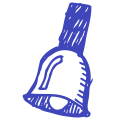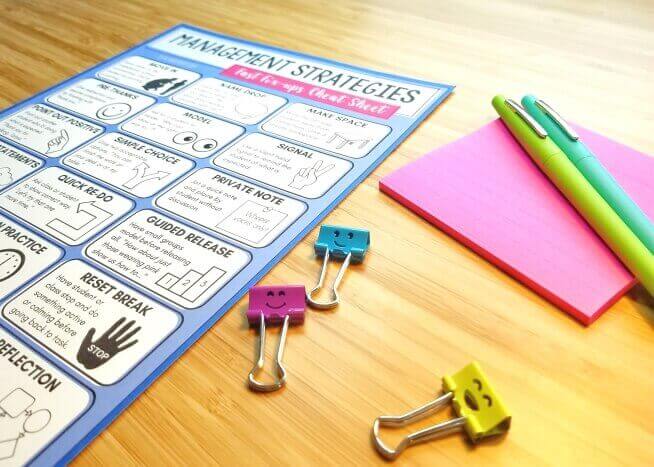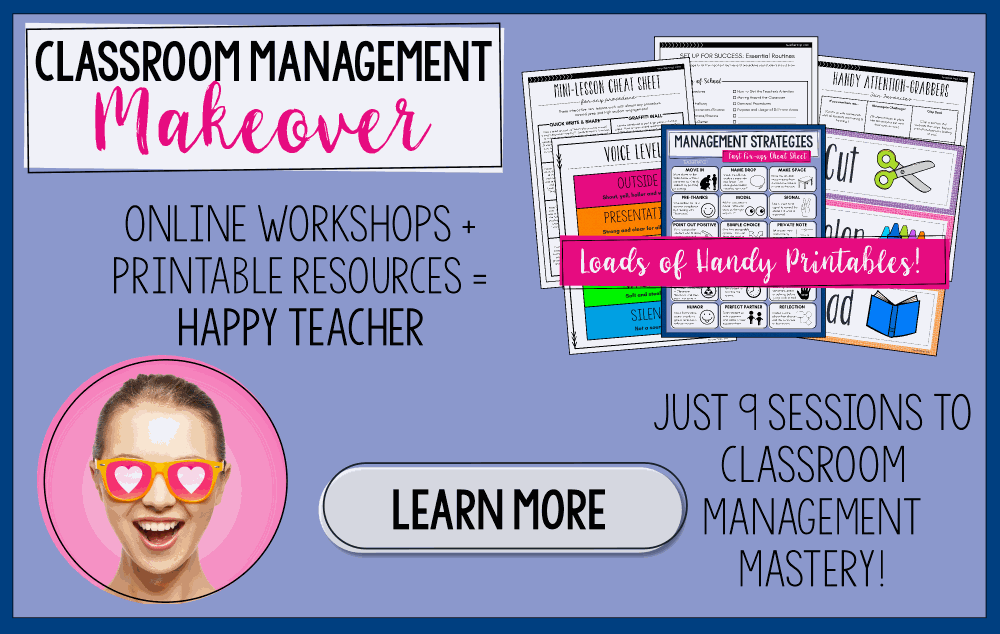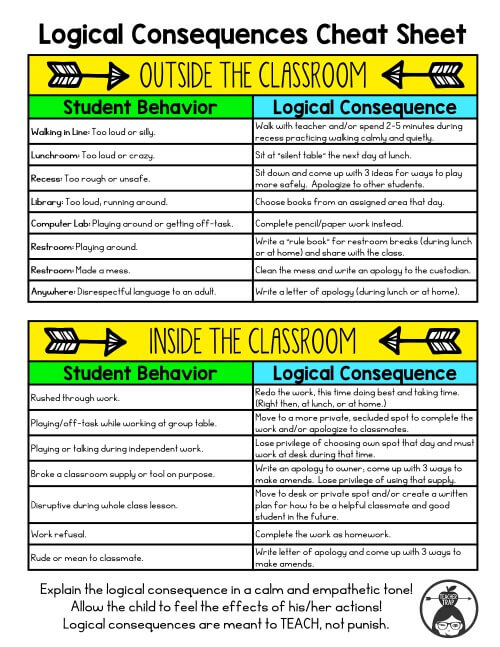
When you’re having a tough school year, classroom management can easily regress into a negative mess of doling out punishments.
That’s 5 minutes off your recess! You owe me a lap! Move your clip! You owe me a dollar! You just lost a ticket! That’s a folder mark!
We use these phrases and punishments to coerce students into doing what is expected. Unfortunately, this type of management can lead to negative effects on the students, the classroom community, AND the teacher! In this post, I’d like to talk about the dangers of using punishments to control students and share some ideas for a classroom management makeover! This topic (and my stance) might not sit well with some, but hopefully I can give some fresh ideas to those of you struggling with a tough group of kids. 🙂
First, let’s think about what it means to use punishments to control student behavior. When we do this, we’re relying on two BIG ASSUMPTIONS:
1. That students KNOW how to behave and are CHOOSING not to do so.
2. That students WILL behave if threatened (or bribed) accordingly.
In my experience with children, these are both FALSE assumptions. Yes, occasionally there are instances with some students who are perfectly aware of what they should be doing and simply choose not to do it. But in most cases, I find that children want to please. Children want to feel accepted, loved, and proud of themselves.
Most behavior problems in the classroom can be traced back to one of three things: poor classroom management, the student struggling with self-control (for a variety of reasons), or the student not knowing how to handle something (a feeling, a friend, a task, etc.).
In each of those three cases, punishments will not solve the real problem.
So let me start by answering 3 questions that I think are central to this discussion.
Do punishments work?
It depends what you’re working for. Quick compliance? Sure! Threaten a punishment and you’re likely to get compliance. Students who behave only when you’re monitoring them? Yes! Punishments are perfect for this!
But if you want students to grow problem-solving skills, self-control, and self-awareness, punishments won’t get you very far. In fact, punishments can be counterproductive to all of those things because students spend their energy learning to avoid getting caught and then being angry or sad when they do! There’s no room for real problem-solving in a punishment-happy classroom.
Do punishments lead to long term success for kids?
If students are carefully controlled in their formative years, will they be more likely to show self-control and good decision-making later in life? My common sense tells me NO. Here’s why. Students who are already struggling with self-control and decision-making are typically the ones who get to enjoy all those punishments. And what happens when you add negative attention to an already shaky sense of self-esteem? Lower self-esteem! Find me an example of a time when low self-esteem combined with poor self-control and decision-making skills led to anything good.
Do punishments make life easier for the teacher?
I’ve heard some teachers say they use punishments because they don’t have time to teach students how to behave. We have a rigorous curriculum to teach! But here’s my observation. The teachers who focus on punishments to control their classroom are often the teachers who seem the most stressed out and frustrated! (Probably because it’s not working.) All the time that’s spent managing problem behavior could be shifted into time for teaching and reinforcing better behavior, which actually would make life easier for the teacher!
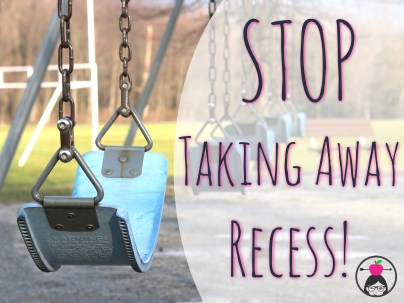
The Big Problems With Punishment
Problem #1: Using punishments to control your classroom makes YOU focus more on problem behavior.
If you’re using a punishment based system, you can’t avoid looking for problems. You’re training yourself to notice (and respond to) the times when students are off-task, talking out, messing around, etc. I’m a firm believer that wherever you put your attention and energy, you’ll get more of THAT! Negativity grows negativity.
At one point in my teaching career when I had a really difficult class, I decided to create a spreadsheet where I’d mark checks next to the students’ names for each infraction. (Yes, I really did this.) At the end of the day, I’d add up the checkmarks to determine how much recess the student should miss the next day. This system lasted for two days. After just two days of constantly monitoring every bad choice and mistake, I was exhausted and unhappy, my students’ behavior was worse than ever, and we were all a nice miserable mess. The next day, I showed up to school and decided to ONLY notice and point out the good choices I saw. It was like magic. Within the first hour of school, I felt happier and the kids were making better choices all around. Of course, just being positive doesn’t fix everything, but it was better than it had been!
Problem #2: Using punishments to control your classroom INCREASES problem behavior.
For a time, I was using a color clip chart to monitor student behavior. I’d ask students to move their clips up or down a color-coded chart in response to good or poor choices. The “bad” colors were linked to punishments while the “good” colors earned students privileges. After doing this for about a month, I noticed something concerning. The SAME students were ending each day on the best color, and the SAME students were ending each day on the worst color. This system wasn’t helping my kids improve, it was simply showing what they already did. (And it was a pain for me to monitor.)
Using punishments might work as a short-term solution, but it doesn’t help improve student behavior in the long run. There is a CAUSE behind a student’s poor choices. You might have students who struggle with self-control due to immaturity, ADHD, chaos at home, poor sleep, or lack of nutrition. Does punishment change any of those factors? If you don’t identify and address the real cause, the outcome will be the same regardless of threats or promised rewards.
Classroom Management Makeover Tips
There are ten highly effective strategies that can help you create a positive classroom full of thoughtful decision-makers! You might notice that almost all of these strategies are PREVENTATIVE. The work is done before the problem arises! The key is to start thinking in terms of prevention rather than punishment.
1. Create effective routines.
Take a look at your school day. Are there times when students aren’t sure what to do? Are there certain times when behavior problems seem to be the worst? Are there some problems that seem to repeat every single day?
Identify those times of day or issues and create routines that eliminate those problems! For example, one year I had a class that ALWAYS struggled with lining up. It was a first grade class with a bunch of boys and they always wanted to race and fight over who was where in line and who touched who and who said what. I tried doing a boy-girl-boy-girl line and I tried assigning spots with numbers, but it wasn’t cutting it. Finally, I created a new routine that worked. When it was time to line up I called on students who were sitting quietly and wanted to show the rest of the class the right way to line up. I’d call on a few students and we’d watch them line up and praise how they walked quietly and stood with hands at their sides. Then I’d call a few more and we’d observe the line again. I wouldn’t call more students until those already in line were perfect! Eventually the whole class would be lined up and ready. This routine took a few minutes in the beginning and a week later, took less than minute. The routine fixed the problem!
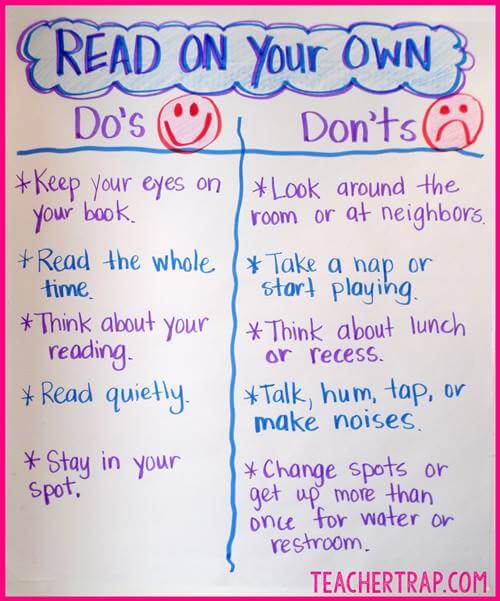
2. Teach and practice procedures often.
As you create those awesome routines from Number 1, make you sure you teach them clearly and PRACTICE them often. I realize that by December, third-graders should be able to line up for lunch without chaos. But if they can’t, teach the routine again and require students to practice it! Practice as a class, have students model, and review as needed. In my experience, practicing a routine gets tedious enough that students will change their behavior to avoid it! 🙂
3. Review expectations like crazy.
Even in May, I still restate my expectations before sending my students off to silent reading time. I still make a point to say, “I expect you to use this time wisely and to help yourself become a better reader. Choose a smart spot. Read the whole time. Focus on your reading.” I keep posters that list expectations up all year and refer to them often. These quick reminders have helped me avoid hours of frustration!
4. Reflect on expectations often.
I like to use a quick thumbs-up, thumbs-down reflection after different activities throughout the day. We do this ALL YEAR. For example, after Math Rotations, I ask students to hold up their thumbs and show me how they did today. Then I read the different expectations and students do a quick reflection. Did you… ‘use a whisper voice’? Did you… ‘stay on task the whole time’? Did you… ‘cooperate with your partner’? Did you… ‘make choices that help you learn’?
This simple routine makes an enormous difference! And sure, students aren’t always honest, but you’d be surprised how often they are. Just the act of thinking about their own behavior in a punishment-free zone seems to help them become more aware of their choices. I’ve seen massive changes in student behavior after just a few days of this kind of reflection.

5. Build in simple incentives.
This little trick made a HUGE difference in my room. It’s actually a form of a logical consequence, which is really just a form of punishment, but the tone and feel of it is very different than a typical punishment. Here’s how it works. As I create our daily routine, I make sure to include simple little perks that students will enjoy. Then I make sure students understand that in order to enjoy these privileges, they must show good decision-making. For example, during writing time I encourage students to write anywhere they choose. Some kids choose to stand, some go under tables, some sit in beanbag chairs, and some sprawl out on the floor. I explain that I like students to work where they are most comfortable, but if that spot proves to be a distraction or makes writing more difficult for them, they’ll need to go back to their desk. I use a simple signal to let the student know that they should return to their seat. (This only effects that day unless the problem becomes chronic, which could then mean a long-term loss of the privilege.) Because my kids love choosing their own spot, I rarely have any behavior concerns during writing time. If I do, it usually doesn’t happen again the next day!
I look for ways to build in little choices like this throughout the day and remind students that in order to keep these options, they’ll need to display good decision-making!
6. Make school engaging.
This one can be hard with the pressures of testing and curriculum expectations, but it’s also one of the most important. If you’re asking students to sit still and do boring work all day, you’re going to see more behavior problems. It’s simple. Limit the amount of time that students are sitting in one place and limit the amount of time students are doing tedious work. I like to look at the school day and make sure that students spend time working with partners, working in groups, creating something, investigating something, and imagining something every day. Look at your daily schedule and make sure there are plenty of times for movement and hands-on work.
7. Focus on positive behavior.
As I mentioned earlier, I believe that you get more of what you focus on. If you focus your energy on what’s going well and on the good choices you see, more and more of this will start happening in your classroom. If you notice some kids talking during a lesson, say a quick “thanks” to the student who IS listening attentively. If you notice some kids playing around during partner time, point out a partner team that IS working together well. Over time, this becomes a habit and can make a real difference in your classroom!
8. Determine the real cause of the behavior.
Some behaviors go beyond prevention. Even if you set up the perfect routines and provide engaging work, you’ll still have kids who struggle and students who drive you nuts. The trick here is to start paying attention and to find out what’s really going on. Start by asking yourself a round of questions: When does this usually happen? What usually prompts this behavior? Where does this usually happen? Is another student often involved and if so, who? Can you identify a situational cause to the behavior? If so, you can then take steps to prevent this problem. You can also talk with the student and ask questions about the behavior: How is this working for you? When you do this, what do you really want? When you do this, what are you thinking will happen next? What would be a better choice? What would help you make a better choice?
If the behavior is severe and/or chronic, you might need to move to next steps like documentation and meeting with parents. Again, I’d recommend keeping the focus on determining the cause of the behavior and looking for a way to prevent it. For example, one year, I had a little boy with sensory processing issues. Every morning, he entered the classroom like whirlwind and didn’t start to calm down for about an hour, if at all. After meeting with his parents, who were also concerned, we found some information about how swinging and spinning can positively impact students with these struggles. At the time, I had a student teacher and we worked out a plan where she’d take him (and any other students that arrived early) to the playground until the bell rang. The kids were only allowed to swing or spin for the 5 to 10 minutes they were outside. The change in the student was profound. I also required him to spend the first part of recess spinning or swinging. These simple changes helped prevent many of the behaviors we were struggling with. Would I have been able to punish this behavior out of the child? (Haha. I tried that. It didn’t work.)
Just to be clear, I realize that not all cases are so simple and that not everyone has a student-teacher on hand for such an odd solution. My point is that it’s more effective to look for the root cause of the problem and seek creative solutions than to push forward with potentially harmful punishments.
9. Use logical consequences.
I’ve heard using “logical consequences” be described as “making the punishment fit the crime.” I’m not a fan of that explanation though. I think of logical consequences as more of a “here’s what you need to learn and practice” or “this behavior leads to this outcome.”
My logical consequences are often connected to the incentives I’ve built in, as mentioned in Number 5. I want students to understand that if they are having a hard time doing something as expected, we’ll have to find another way. Let’s say all the kids are working at their group tables, but one student is being loud and silly. I typically give a reminder or warning first. If the behavior continues, I’d then walk over and privately say, “It looks like you’re having a hard time completing your work with all these kids nearby. Go ahead and move over to the quiet table so you can concentrate.” I say it with kindness and then let the student feel the effects of his choices. In reality, it’s still a form of punishment, but because of the positive delivery and clear connection to his behavior, I find students are more able to make sense of how their choices lead to the outcome.
I’ve created a Logical Consequences Cheat Sheet that can be used as a handy reference tool. You can download it for FREE in my TPT Store.
10. Teach students to think about outcomes.
One powerful way to help students think about the effects of their choices and behavior is to create Social Behavior Maps. Social mapping is a great tool that can help your students understand how their choices lead to different outcomes. I love using this with the whole class at the beginning of the year, in small groups during the year, and individually with students who are having bigger behavior issues. In a nutshell, students think about the decision made and how that decision impacts themselves and others.
If you’re struggling with a specific student you might want to check out my post: How to Love a Kid Who’s Really Tough to Love. Otherwise, I hope you found some helpful tips here!! And as always, feel free to share your own tips in the comments! 🙂


